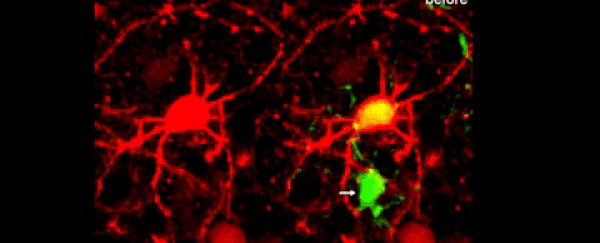We already know that our brains have a waste disposal system that keeps dead and toxic neurons from clogging up our biological pathways. Now, scientists have managed to capture a video of the process for the first time, in laboratory tests on mice.
There's still a lot we don't know about how dead neurons are cleared out, and how the brain reacts to them, so the new research could be a significant step forward in figuring some of that out – even if we've not yet confirmed that human brains work in the exact same way.
"This is the first time the process has ever been seen in a live mammalian brain," says neurologist Jaime Grutzendler from the Yale School of Medicine in Connecticut.
Further down the line, these findings might even inform treatments for age-related brain decline and neurological disorders – once we know more about how brain clean-up is supposed to work, scientists can better diagnose what happens when something goes wrong.
The team focussed in on the glial cells responsible for doing the clean-up work in the brain; they used a technique called 2Phatal to target a single brain cell for apoptosis (cell death) in a mouse and then followed the route of glial cells using fluorescent markers.
"Rather than hitting the brain with a hammer and causing thousands of deaths, inducing a single cell to die allows us to study what is happening right after the cells start to die and watch the many other cells involved," says Grutzendler.
"This was not possible before. We are able to show with great clarity what exactly is going on and understand the process."
Three types of glial cells – microglia, astrocytes, and NG2 cells – were shown to be involved in a highly coordinated cell removal process, which removed both the dead neuron and any connecting pathways to the rest of the brain. The researchers observed one microglia engulf the neuron body and its main branches (dendrites), while astrocytes targeted smaller connecting dendrites for removal. They suspect NG2 may help prevent the dead cell debris from spreading.
The researchers also demonstrated that if one type of glial cell missed the dead neuron for whatever reason, other types of cells would take over their role in the waste removal process - suggesting some sort of communication is occurring between the glial cells.
Another interesting finding from the research was that older mouse brains were less efficient at clearing out dead neural cells, even though the garbage removal cells seemed to be just as aware that a dying cell was there.
This is a good opportunity for future research, and could give experts insight into how older brains start to fail in various ways, as the garbage disposal service starts to slow down or even breaks.
New treatments might one day be developed that can take over this clearing process on the brain's behalf – not just in elderly people, but also those who have suffered trauma to the head, for example.
"Cell death is very common in diseases of the brain," says neurologist Eyiyemisi Damisah, from the Yale School of Medicine.
"Understanding the process might yield insights on how to address cell death in an injured brain from head trauma to stroke and other conditions."
The research has been published in Science Advances.
